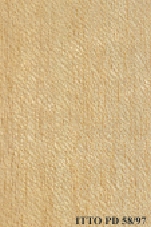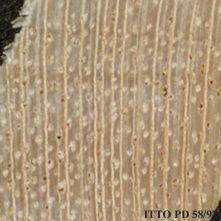
MOROTOTO (Didymopanax morototoni)
Trade Name
Morototo
Scientific Name
Didymopanax morototoni (Aubl.) Decne. & Planch.
Family
ARALIACEAE
Common Names
Yagrumo macho; Tobitoutou; Sun sun; Sancha uva; Orumo macho; Mor; Macho; Kasavehout; Karoboro; Jereton; Higueroton; Ambayguazu; Roble Blanco (Mexico); Korohoro (Guyana); Yagrumo (Cuba); Anonilla (Peru); Platanillo (Ecuador); Yarumero (Colombia); Pata De Gallina (Colombia); Borracho (Bolivia); Morototo (Brazil); Matataúba (Brazil); Sacha Uva (Peru); Saint Jean; Mucututu (Brazil); Mountain Trumpet; Matetauba; Marupaúba Falso (Brazil); Karohoro; Guitarrero (Bolivia); Costilla De Danto; Cordoban; Chancaro Blanco; Cassavehout; Bigi Boesie; Badana; Arriero; Arbre De Saint Jean; Anonillo; Mandioqueira (Brazil); Yagrumo De Savana; Pará Pará (Brazil); Cordovan; Cafetero (Venezuela); Yagrume Macho; Yagrume; Tinajero (Venezuela); Sunsun (Venezuela); Matchwood
Scientific Name Synonyms
Sciadophyllum paniculatum Britton; Schefflera morototoni (Aubl.) Maguire, Steyerm. & ; Panax undalata Aubl.; Panax splendens Kunth; Panax morototoni Aubl.; Didymopanax poeppigii Decne. & Planch.; Didymopanax morototoni var. poeppigii (Decne. &P
Description Of The Tree
Botanical Description
The trees are reported to reach heights of 35 m, with trunk diameters of 70 cm. They develop well-formed and cylindrical boles that are up to 25 m long.
Natural Habitat
Didymopanax morototoni is a pioneer species widespread in the tropical rain forests of tropical America. It is a typical tree of open and secondary forests.
Natural Distribution
It is commonly found in the forests of tropical America. The species is distributed from Mexico southward to Peru and Bolivia. It is also reported to grow in the Caribbean.
Wood Identification
Anatomic Description Of Wood
Wood diffuse porous. Vessels in radial multiples of 2 to 4. Tangential diameter of vessel lumina 100 micras or less (very small). Vessels per mm2 more than 20 (very abundant). Scalariform perforation plates with 5 to 15 bars. Vessel-ray pits similar to interve Axial parenchyma absent or extremely rare, non visible with magnifying glass (8x). Occasionally apotracheal axial parenchyma diffuse and/or diffuse in aggregates. 3 to 4 cells per parenchyma strand. Rays less than 4 per mm (rare). Larger rays more than 4 seriate. Body ray cells procumbent with one row of upright and/or square marginal cells (Kribs-III). Septate fibers present. Fibers with simple to minutely bordered pits.
-
 Wood Macro Photo Radial Plane
Wood Macro Photo Radial Plane
-
 Wood Micro Photo Of Transversal Section
Wood Micro Photo Of Transversal Section
Availability
Cites Status
Unrestricted
General Wood Description
Odor
There is no characteristic odor or taste.
Color
The sapwood is lighter in color than the heartwood, and is usually not well differentiated. Heartwood of timbers in this species is reported to vary in color from gray white to beige white.
COLOR INDEX (1=Black, 7=Light yellow,white)
6
Grain
Grain is reported to be typically straight.
Texture
Texture is reported to be medium.
Luster
This species is reported to have medium to high luster.
Natural Durability
This species has low natural resistance against wood degrading agents.
Natural durability index (1= Very high durability, 7=Vey low durability)
5
Wood Physical Properties
Basic Density or Specific Gravity (O.D. weight/vol. green) (g/cm³)
0.49
Air-dry Density (Weight and volume at 12%MC) (g/cm³)
0.53
Total shrinkage Tangential (Saturated to 0%MC) (%)
7.4
Total shrinkage Radial (Saturated to 0%MC) (%)
5.3
Drying Defects
Drying Defects: Little tendency to warp or check while seasoning.
Recommended Dry Kiln Schedule
BR-B; JUNAC-A
Dimensional stability ratio (Total Tangential Shrinkage %/Total Radial Shrinkage %)
1.4
Wood Chemical Properties
Wood Mechanical Properties
Bending Strength (MOR),12%MC (kgf/cm²)
759
Stiffness (MOE) 12%MC (kgf/cm²)
113706
Compression parallel to fiber 12%MC (kgf/cm²)
405
Compression perpendicular to fiber 12%MC (kgf/cm²)
36
Shear strength radial 12%MC (kgf/cm²)
87
Janka hardness (side) 12%MC (kgf)
317
Janka hardness (end grain) 12%MC (kgf)
442
Workability
Sawing
Sometimes it produces woolly surfaces.
Rotary Veneer Cutting
This species is reported to be interesting for peeling and for slicing.
Sliced Veneer
This species is reported to be interesting for peeling and for slicing.
Blunting Effect
It has a slight blunting effect on the cutting tools.
Planing
Planing poses no difficulty, but sometimes woolly surfaces are reported. Tendency to produce fuzzy grain when planing.
Moulding
Molding operations are rather easy.
Turning
30
Boring
This species is easy to bore.
Mortising
Mortising operations are rather easy.
Nailing
Good nail-holding properties.
Gluing
This species is easy to glue.
Sanding
It is easy to sand.
Finishing
Finishing of this wood is easy.
Staining
It has a good staining.
Coatings
Painting or varnishing of this species is reportedly easy.
Polishing
Polishing of this species is reportedly easy.
Response To Hand Tools
This species is reported to be easy to work manually.
Substitute Species
Simarouba spp.
REFERENCED USES
End Uses Summary
HOUSING GENERAL, steps, panelling, fittings, shutter boards, FURNITURE AND CABINETS, common furniture, PLYWOOD AND VENEER, faces, common veneer, TURNING, lasts, SPORTS, table tennis, PACKING, light packing, OTHER AND MUSICAL INSTRUMENTS, handicrafts, pencil, matches, toothpicks, door core, moldings
General Housing
- 10 - Silica in Timbers
Steps
- 17 - Tree Conservation Database
Paneling
- 18 - W3TROPICOS Missouri Botanical Garden
Fittings
- 19 - Silica in Timbers
Shutter Boards
- 20 - Prospect: The wood database
Furniture Cabinets
- 21 - Tropical timbers of the world. Part III-Southeast Asian and Oceanian Species.
Furniture, Common
- 23 - Handbook of Hardwoods
Panels, Veneers
- 25 - Directory of Timber Trade Malaysia
Faces
- 26 - Annual Review and Assessment of the World Timber Situation 1998-ITTO
Common Veneer
- 29 - Embassy of Ecuador in Japan
Turning
- 30 - Embassy of Honduras in Japan
Lasts
- 34 - Embassy of Indonesia in Japan
Sports
- 38 - Annual Review and Assessment of the World Timber Situation 1998-ITTO
- 41 - Embassy of the Philippines
Packing
- 45 - Recopilación y Análisis de Estudios Tecnológicos de Maderas Peruanas
Light Packing
- 46 - ECUADOR, Inventario y Aprovechamiento de los Bosques del Sur Ecuatoriano
Other & Musical Instruments
- 63 - Madeiras do Brazil II
Handcraft
- 66 - Maderas latinoamericanas. VII. Caracteristicas anatomicas. propiedades fisicomecanicas, de secado, y tratabilidad de la madera juvenil de Cordia alliodora (Ruiz & Pav. Oken.)
Pencils
- 67 - Maderas latinoamericanas. VIII, Calophyllum brasilense, Couratari panamensis, Dendropanax arboreum y Bombacopsis sessilis
Matches
- 71 - Proprietes physiques et mecaniques des bois tropicaux, premier supplement
Tooth Picks
- 72 - Proprietes physiques et mecaniques des bois tropicaux, deuxieme supplement
Door Cores
- 76 - Descripción General y Anatómica de 105 Maderas del Grupo Andino.
Molding
- 79 - Padronização da Nomenclatura Comercial Brasileira das Madeiras Tropicais Amazônicas, Sugestão
Please Provide Information To View Producer Information